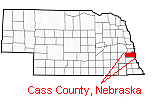 Perhaps one of the best known invertebrate fossils from the Pennsylvanian-Permian strata of southeastern Nebraska is the solitary horned coral. Pseudophrentoides verticillatus (Barbour) is one of several species of these animals to have been found in Nebraska. These corals are usually abundant when they are found. In 1964 Robert f. Diffendal, Jr., recorded a bed of these corals in the Plattsmouth Limestone member of the Oread Formation. The bed of corals that Diffendal studied is centered in the area just north of Nehawka, Cass County, Nebraska, and it extended to the west for about 4 miles and was only one or two miles wide. The bank was of a local nature and the corals and associated fauna became less abundant and few corals were found in the Plattsmouth at a distance of 10 miles from the bank. Such corals were probably suspension feeders that extracted food particles from the overlying water column.
Perhaps one of the best known invertebrate fossils from the Pennsylvanian-Permian strata of southeastern Nebraska is the solitary horned coral. Pseudophrentoides verticillatus (Barbour) is one of several species of these animals to have been found in Nebraska. These corals are usually abundant when they are found. In 1964 Robert f. Diffendal, Jr., recorded a bed of these corals in the Plattsmouth Limestone member of the Oread Formation. The bed of corals that Diffendal studied is centered in the area just north of Nehawka, Cass County, Nebraska, and it extended to the west for about 4 miles and was only one or two miles wide. The bank was of a local nature and the corals and associated fauna became less abundant and few corals were found in the Plattsmouth at a distance of 10 miles from the bank. Such corals were probably suspension feeders that extracted food particles from the overlying water column.
The polished slab shows corals in both transverse and longitudinal sections. Corals must be classified by studying the manner in which the septa and tabulae are added into the skeleton during growth. Thin sections are needed to show these internal changes. The thin sections trace the growth of the coral and allow the paleontologist to study how the septa and tabulae were added inside. Some examples of this species show that they propagated themselves by asexual cloning as shown by buds of young corals on the corallite of larger. Some corallites have hemispherical depressions that probably mark where buds dropped off of their parent.
In 1966, Robert Schrott recorded a large concentration of corals from the Beil Limestone member of the Lecompton Formation. Gordon Baird 1n 1971 described and re-interpreted the coral horizon in the Beil Limestone. Baird reported that the corals from the Beil Limestone, in contrast to the corals from the Plattsmouth Limestone, covered a much larger area that extends from Cass County, Nebraska, into Mills and Montgomery counties, Iowa; Holt County, Missouri; and Doniphan, Atchison, and Douglas counties, Kansas. Unpublished fieldwork of Roger Pabian suggest that the Beil coral horizon extends into Greenwood County, Kansas.
Outcrop of King Hill Shale and Beil Limestone Members of the Lecompton Formation, Cass County, Nebraska
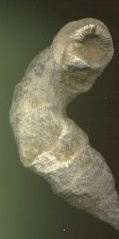

Pseudozaphrentoides verticillatus
Description: Polished slab showing transverle and longitudinal sections through corallites of "Pseudozaphrentoides verticillatus" (Barbour). Note the crowding of specimens. Photo by R. F. Diffendal, Jr.
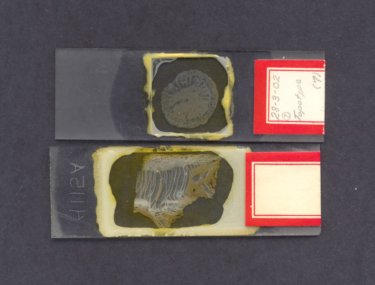
Pseudozaphrentoides verticillatus
Description: Transverse (above) and longitudinal (below) thin sections through corallite of "P. verticillatus" (Barbour).
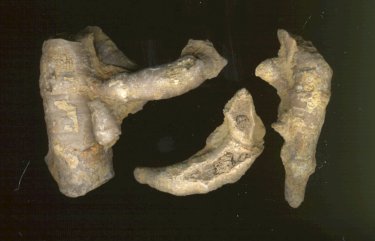
Pseudozaphrentoides verticillatus
Description: Corallites of "P. verticillatus" (Barbour) showing asexually reproduced clones protruding from parent coarllites.
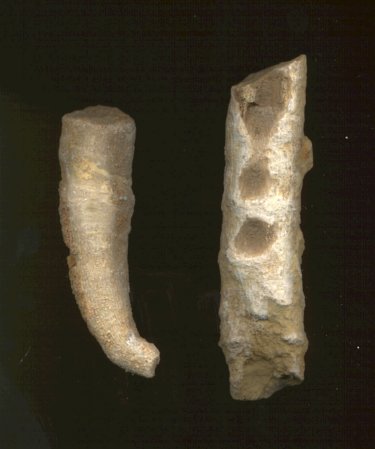
Pseudozaphrentoides verticillatus
Description: Normal corallite (left) and scarred corallite (right) of "P. verticillatus" (Barbour) that shows where asexually reproduced clones have formed.
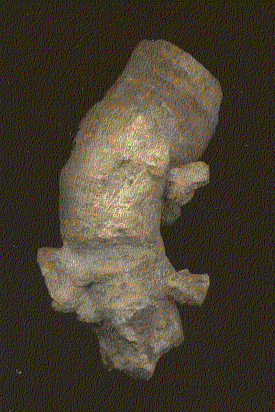
Pseudozaphrentoides verticillatus
Description: Paratype specimen of "P. verticillatus" (Barbour) showing several asexually reproducing clones.
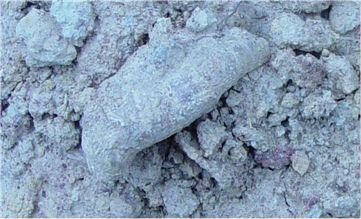
Pseudozaphrentoides verticillatus in place
Description: Corallite of "Pseudozaphrentoides verticillatus" (Barbour) in place in weathered Beil Limestone, Cass County, Nebraska.
References
- Baird, G. C., 1971. Paleoecology of the Beil Limestone (Upper Pennsylvanian) in the Northern Midcontinent Region. University of Nebraska, Unpublished MS Thesis, 151 p.
- Diffendal, R. F., 1964. Paleoecology of Pseudozaphrentoides verticillatus (Barbour) in the Plattsmouth Limestone (Pennsylvanian). University of Nebraska, Unpublished MS Thesis, 71 p.
- Schrott, R. O., 1966. Paleoecology and stratigraphy of the Lecompton Megacyclothem (Late Pennsylvanian) in the Northern Midcontinent Region. University of Nebraska, Unpublished PhD Dissertation, 329 p.
